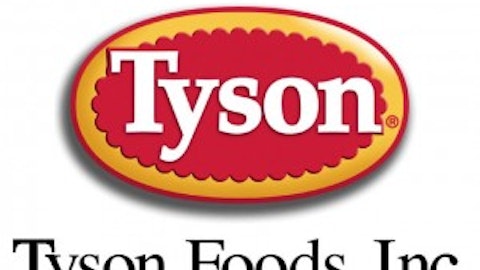Hormel Foods Corp (NYSE:HRL) was founded in 1891 by George Hormel in the small town of Austin Minnesota.
Today, Hormel has a market cap of $17.4 billion. The company has assembled a portfolio of well-known food brands. The image below shows many of the company’s most popular brands.
Source: Hormel Foods Company Website
Hormel operates in the slowly changing packaged meat and packaged food industry. The stability of the industry in general, and Hormel in particular, has resulted in a tremendous streak of dividend growth.
However, smart money are not that impressed about the company. According to our database of around 730 hedge funds, only 21 held long positions in the company at the end of June and while this number went up by six during the second quarter, the aggregate value of their stakes increased slightly to $258.41 million and represented only 1.70% of the outstanding stock. Among them, the two largest shareholders were Cliff Asness‘ AQR Capital Management and Joel Greenblatt’s Gotham Asset Management. AQR inched up its position to 1.28 million shares, while Gotham reported a new stake of 1.16 million shares in its last 13F filing.
Hormel has raised its dividends for 49 consecutive years. In 2016, the company will join the exclusive Dividend Kings – dividend stocks with 50+ consecutive years of dividend increases. Click here to see all 17 Dividend Kings analyzed.
Hormel’s Competitive Advantage
More than 30 of Hormel’s brands hold the #1 or #2 position in their respective market category. The company’s competitive advantage comes from built up brand equity.
Over the last 3 years, Hormel has averaged advertising expenditures of about $100 million a year. The company only spends around 1% of sales revenue a year on advertising. This is far below what many other packaged foods companies spend.
Hormel Foods Corp (NYSE:HRL) does not need to advertise as much as its peers because many of its brands are already very well known. Skippy, Spam, and Hormel are all well-known brands. For younger consumers, Applegate Organics, Muscle Milk, and Jennie-O are likely very well known.
Where Hormel differentiates itself from its competitors is its growth through acquisitions. The company has realized excellent growth by acquiring up-and-coming brands and then growing them.
Growth Prospects & Total Return
Recent examples of large acquisitions for Hormel are CytoSport (makers of Muscle Milk) and Applegate Organics.
CytoSport was acquired for $450 million. Applegate Organics was acquired for $775 million. Older acquisitions for Hormel that were transformative for the company were the 2001 acquisition of Jennie-O Turkey, and the 2013 acquisition of Skippy peanut butter.
Hormel has used the cash flows from its slower growing but established meat brands like Dinty Moore and Spam and used them to acquire brands with great potential like Jennie-O, Applegate, and Muscle Milk.
Hormel’s growth story is far from over. The company’s management says it has another $3 billion in debt capacity. This will likely be used for additional acquisitions that match the company’s criteria.
Recent history shows that Hormel is looking for brands that appeal to millennials and focus on health benefits and/or high protein.
Hormel’s growth strategy has worked out well for shareholders. The company has compounded earnings-per-share at 10.5% a year over the last decade. Dividends have grown even faster over the last decade – at 13.3% a year.
Amazingly, the company has grown earnings-per-share in 27 out of its last 30 years. The primary sources of the company’s earnings-per-share growth over the last decade are shown below:
- Sales have grown at 6.7% a year
- Net profit margin has grown at 3.7% a year (from 4.7% in 2005 to 6.5% in 2014)
Increasing sales have been the biggest growth driver for Hormel. This shows the company’s products are in demand – and that it can successfully integrate and expand its acquired brands.
As a note, Hormel has not grown at the expense of shareholders. The company’s share count has actually decreased by about 0.5% a year over the last decade.
Net profit margin has also increased significantly for Hormel over the last decade. The company’s margins have increased as it acquires higher margin brands. The company is also growing larger and can realize better economies of scale by eliminating redundancies resulting from acquisitions.
Going forward, I expect Hormel to continue growing earning-per-share somewhere between 9% and 11% a year. In addition, the company has a dividend yield of 1.5%. Shareholders should expect total returns of 10.5% to 12.5% a year going forward from Hormel.
Recession Performance
During recessions, people still need to eat. Hormel’s packaged food products are cheaper than dining out. When times get tough, one would expect the company’s earnings to rise rather than fall.
As it turns out, that is what happened during the Great Recession of 2007 to 2009. The company’s earnings dipped slightly in 2008 before recovering to new highs at the height of the Great Recession in 2009.
Hormel’s earnings-per-share through this period are shown below:
- 2007 earnings-per-share of $1.07 (new high)
- 2008 earnings-per-share of $1.04 (2.8% decline)
- 2009 earnings-per-share of $1.27 (new high)
Hormel Foods Corp (NYSE:HRL) is recession resistant. The company’s streak of 27 earnings-per-share increases in the last 30 years shows the company can thrive in a variety of economic environments.
Hormel’s Valuation & Final Thoughts
Over the last decade, Hormel stock has traded for an average price-to-earnings ratio of around 17.
Given its safety, slow-changing industry, growth potential, and double-digit expected total returns a ‘fair’ price-to-earnings ratio for the company is likely closer to 20.
Unfortunately for value-conscious investors, Hormel’s price-to-earnings ratio has risen substantially in the last 2 years. The company is currently trading for a price-to-earnings ratio of 26.6 – well above its historical average.
Now is not the most opportune time to initiate a position in Hormel given its high current valuation.
With that said, Hormel is an exceptionally high quality business. There are little doubts that the company will continue growing its earnings and rewarding shareholders with rising dividends. In fact, it’s difficult to envision what could actually stop the company from growing over the long run.
Hormel ranks fairly highly in spite of its high valuation using The 8 Rules of Dividend Investing. That’s because the company scores high marks for growth, low stock price volatility of 19.6%, and a fairly low payout ratio of under 40%.
Low stock price volatility is a proxy for risk. Interestingly, low volatility stocks have historically outperformed the market. Low payout ratios give Hormel plenty of room to continue growing its dividend payments faster than earnings-per-share growth for the next several years.
There’s no doubt Hormel is an excellent business and shareholder friendly. At current prices, it is a hold. I would wait for a price-to-earnings ratio under 20 (and preferably under 17) to initiate or add to a position in Hormel.
Disclosure: None





